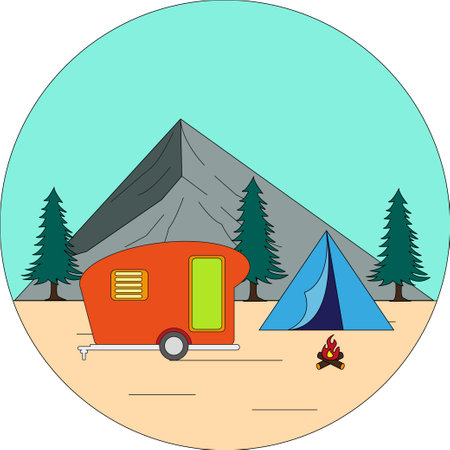1. Choosing the Right RV for Winter Conditions
When it comes to winter RV camping, not all rigs are created equal. If you plan on braving cold temperatures, snow, and icy roads, choosing a winter-ready RV is key to staying warm and safe. Here’s what to look for:
Insulation Matters
A well-insulated RV keeps the heat in and the cold out. Look for models with high-quality wall, floor, and roof insulation. Some RVs even have double-pane windows that help maintain a consistent indoor temperature.
Types of Insulation Commonly Found in Winter-Ready RVs:
| Insulation Type | Description | Benefits |
|---|---|---|
| Fiberglass | Standard in many RVs; provides decent thermal resistance | Cost-effective and widely available |
| Foam Board | Rigid panels used in walls and floors | High R-value per inch; great for extreme cold |
| Spray Foam | Expands to fill gaps and cracks | Excellent air seal and insulation quality |
Heated Tanks and Plumbing
Freezing temperatures can wreak havoc on your water system. A good winter-ready RV includes heated holding tanks and enclosed underbellies to protect pipes from freezing. This feature helps prevent costly damage and ensures you have running water even when it’s below freezing.
Ducted Heating Systems
A ducted furnace system distributes heat more evenly throughout the RV compared to a single-source heater. Some high-end models also include radiant floor heating or heat pumps for added comfort.
Cold-Weather Seals and Skirting Options
Look for upgraded weather stripping around doors and windows. You might also consider using RV skirting during extended stays in cold areas—it helps block wind from getting underneath your rig, which can lower heat loss significantly.
Quick Checklist: What Makes an RV Winter-Ready?
- High R-value insulation in walls, floors, and roof
- Double-pane windows
- Heated fresh, gray, and black water tanks
- Ducted heating system or additional heat sources
- Enclosed underbelly to protect plumbing lines
- Tight seals around windows, doors, and slide-outs
Selecting the right RV with these features will make a big difference in how comfortable—and safe—you stay during your winter adventures.
2. Winterizing Your RV Before Hitting the Road
Before heading out on a winter RV adventure, it’s crucial to winterize your rig to keep everything running smoothly and safely in freezing temperatures. Cold weather can cause serious damage if youre not prepared, but with a few simple steps, you can stay warm and avoid costly repairs.
Seal Drafts to Keep the Warmth In
Cold air can easily sneak into your RV through small gaps around windows, doors, and vents. Use weather stripping or foam tape to seal these areas. Don’t forget to check slide-outs and storage compartments too. Even a small draft can make your furnace work overtime and leave you shivering.
Insulate Pipes and Water Lines
Frozen pipes are one of the most common problems during winter RV camping. To prevent this, wrap exposed pipes and water lines with foam insulation or heat tape. If your RV has an enclosed underbelly, make sure its well-insulated as well. You can also use a heated water hose for added protection.
Common Insulation Methods
| Item | Recommended Solution |
|---|---|
| Water Lines | Foam pipe insulation or heat tape |
| Windows | Reflective foil or thermal curtains |
| Flooring | Rugs or foam mats for extra warmth |
Check Your Furnace and Heating Systems
Your RV’s furnace is your best friend in cold weather, so make sure it’s in good working condition before you hit the road. Clean the vents, replace filters if needed, and test it before your trip. If you’re using space heaters as a backup, only use ones that are rated safe for indoor use in RVs.
Test and Charge Your Batteries
Batteries lose power faster in cold temperatures. Test all batteries—house batteries, engine battery, and any backups—to ensure they’re fully charged and holding power. It’s smart to carry a portable jump starter or battery charger just in case.
Battery Checklist
- Check voltage levels before departure
- Charge batteries fully while connected to shore power
- Keep batteries dry and protected from freezing temperatures
Additional Tips for Prepping Your RV for Winter Travel
- Add RV antifreeze to drains and holding tanks if youre not using them actively
- Use vent covers to block cold drafts from rooftop vents while still allowing airflow
- Stock up on propane—it runs out quicker in cold weather!
- Keep a toolkit handy for quick fixes on the road
Getting your RV winter-ready takes a bit of time up front, but it pays off when you’re parked at a snowy campsite with everything working smoothly. These simple steps will help you stay warm, safe, and comfortable all winter long.

3. Staying Warm Inside Your RV
Keeping your RV warm during winter camping is all about using the right tools and strategies to maintain heat efficiently. Whether youre plugged into shore power or boondocking, here are some practical tips to help you stay cozy without burning through all your propane or electricity.
Use Space Heaters Wisely
If youre at a campground with electric hookups, an electric space heater can be a great way to supplement your RV’s built-in furnace. Ceramic heaters or oil-filled radiators are popular choices because they’re energy-efficient and provide steady heat. Just be sure not to overload your RV’s electrical system—check the wattage limits for your circuit breakers.
Pros and Cons of Common Electric Heaters
| Type | Pros | Cons |
|---|---|---|
| Ceramic Heater | Quick heat-up, compact size | Noisy fan, directional heat only |
| Oil-Filled Radiator | Silent operation, steady warmth | Takes time to heat up, bulky |
| Infrared Heater | Efficient for small spaces, quiet | Less effective in large areas |
Install Thermal Curtains or Reflective Window Covers
Your RV windows can let out a lot of heat if they’re not properly insulated. Thermal curtains help trap warm air inside while keeping cold drafts out. You can also use reflective window covers like Reflectix to block radiant heat loss through windows and skylights. These are especially helpful at night when temperatures drop sharply.
Add RV Skirting for Extra Insulation
Skirting around the base of your RV helps prevent cold air from flowing underneath, which can cool down your floors and freeze pipes. You can buy custom-made skirting or DIY with foam board or heavy-duty tarps. Either way, it adds a big layer of protection against the cold.
Manage Propane and Electricity Usage Smartly
Your RV’s furnace runs on propane and often uses electricity to power the blower fan. To make it last longer:
- Set your thermostat a few degrees lower and wear layers indoors.
- Use electric heaters when hooked up to shore power to save propane.
- Monitor propane levels regularly so you don’t run out during a cold snap.
- If youre boondocking, keep an eye on battery levels since the furnace fan drains power quickly.
Energy Usage Comparison (Estimated per hour)
| Heat Source | Fuel/Energy Type | Usage Rate |
|---|---|---|
| RV Furnace | Propane + Battery Power | 0.5–1 lb propane/hour + ~8 amps DC/hour |
| Ceramic Heater | Electricity (120V) | 750–1500 watts/hour (~6–12.5 amps) |
| Oil-Filled Radiator | Electricity (120V) | 600–1500 watts/hour (~5–12.5 amps) |
A little planning goes a long way when it comes to staying warm in your RV during winter adventures. Combining insulation tactics with smart energy usage will keep you comfortable no matter how chilly it gets outside.
4. Safety Measures for Cold-Weather Camping
When youre RV camping in the winter, staying warm is only part of the equation—you also need to stay safe. Cold-weather conditions can bring unique hazards, so its important to take a few key safety precautions before and during your trip. Heres what you need to know.
Carbon Monoxide Detectors Are a Must
Many RVers use propane heaters or generators to keep warm, but these can produce carbon monoxide—a colorless, odorless gas that can be deadly if it builds up inside your RV. Make sure your RV has a working carbon monoxide detector, and test it before every trip. Replace batteries regularly and never ignore an alarm, even if you think it’s just a false alert.
Proper Ventilation Keeps You Safe
It might seem counterintuitive, but cracking a window or vent slightly can actually help you stay safer and warmer. Proper ventilation prevents moisture buildup (which leads to mold and freezing windows) and allows harmful gases like carbon monoxide to escape. Always follow manufacturer guidelines when using space heaters or propane appliances inside your RV.
Emergency Kits: Be Ready for Anything
Winter weather can change fast, and sometimes things don’t go as planned. That’s why having a well-stocked emergency kit is essential. Here’s a quick list of items every winter RVer should have:
| Item | Why Its Important |
|---|---|
| Blankets & Extra Warm Clothing | Helps retain body heat in case of heater failure |
| First Aid Kit | Treats minor injuries on the road |
| Flashlights & Batteries | Keeps you prepared during power outages or low visibility |
| Non-perishable Food & Water | Sustains you if youre snowed in or stranded |
| Shovel & Ice Scraper | Clears snow from around your RV and tires |
| Portable Phone Charger | Keeps communication lines open in an emergency |
Tire Safety in Freezing Conditions
Your tires are your first line of defense against icy roads. Cold temperatures can lower tire pressure, which affects traction and handling. Check your tire pressure often and make sure its at the manufacturer-recommended level. Also, consider carrying tire chains if youre headed into snowy or mountainous areas—theyre required by law in some states during winter months.
Quick Tire Safety Tips:
- Inspect tread depth before hitting the road—worn-out tires won’t grip well on icy surfaces.
- Store tire chains where they’re easy to access.
- Avoid sudden braking or sharp turns on icy roads.
By following these safety measures, youll not only stay warm but also enjoy peace of mind knowing youre prepared for whatever winter throws your way.
5. Best Winter RV Destinations in the U.S.
Winter RV camping doesn’t mean you have to stay stuck in the snow—unless you want to! The United States offers a wide variety of winter-friendly RV destinations, whether youre chasing snowy adventures or looking for sunny skies and mild temperatures. Here are some of the best spots to park your rig this winter season.
❄️ Snowy Escapes for Winter Wonderland Lovers
If you’re into skiing, snowshoeing, or just love waking up to a fresh blanket of snow, these cold-weather destinations are ideal for a true winter camping experience.
| Destination | State | Why Its Great |
|---|---|---|
| Lake Tahoe | California/Nevada | Ski resorts, snow activities, and scenic mountain views |
| Mount Hood National Forest | Oregon | Quiet forested sites with access to cross-country skiing and snowboarding |
| Estes Park (Rocky Mountain National Park) | Colorado | Snow-covered peaks and wildlife viewing in a true alpine setting |
🌞 Warm-Weather Winter Getaways
If you prefer to escape the cold altogether, head south where the sun shines brighter and the temperatures stay mild. These destinations offer comfortable climates perfect for winter RV living.
| Destination | State | Why Its Great |
|---|---|---|
| Quartzsite | Arizona | A desert haven popular with RVers; big open spaces and warm temps |
| The Florida Keys | Florida | Tropical vibes, ocean views, and plenty of campgrounds near the beach |
| Big Bend National Park | Texas | Mild winters and stunning desert-mountain scenery great for hiking and stargazing |
⛺ Tips for Choosing Your Winter RV Destination
- Check campground availability: Some parks close or reduce services in winter months. Always call ahead or check online.
- Plan for hookups: Full hookups are ideal during colder months so you can run heaters without draining your batteries or propane too fast.
- Pack accordingly: Whether heading into the snow or toward the sun, bring proper gear for comfort and safety.
- Stay weather-aware: Keep an eye on local forecasts and road conditions to avoid surprises along your route.
No matter your idea of the perfect winter escape—whether it’s snuggling up in snowy woods or enjoying sunshine from your campsite patio—the U.S. has a spot that fits your style. Choose wisely, prepare well, and enjoy the season from the comfort of your RV!


